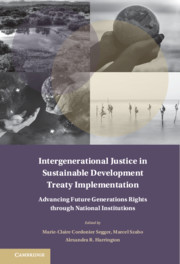 Intergenerational Justice in Sustainable Development Treaty Implementation
Intergenerational Justice in Sustainable Development Treaty Implementation Book contents
- Intergenerational Justice in Sustainable Development Treaty Implementation
- Treaty Implementation for Sustainable Development
- Intergenerational Justice in Sustainable Development Treaty Implementation
- Copyright page
- Contents
- Figures
- Tables
- Notes on Contributors
- Foreword
- Acknowledgements
- Abbreviations and Acronyms
- 1 Introduction
- 2 The Theoretical Framework for International Legal Principles of Intergenerational Equity and Implementation through National Institutions
- Part I Introduction to Treaty Law on Intergenerational Justice and Codifying Sustainability
- Part II Key Challenges in Domestic Implementation of Intergenerational Justice
- Part III Law and Policy Innovations for Intergenerational Justice
- Constitutional Challenges and Innovations for Future Generations
- Promoting the Voice of the Public
- 10 Time to Think: Sustainable Development, Future Generations and the Individual
- 11 Claims and Petitions Regarding Environment Preservation for Future Generations
- 12 Rationale and Means of Public Participation
- 13 Are We Giving the Voice of the Future a Word in the Present?
- Economic Aspects of Intergenerational Justice
- Addressing Science, Scientific Uncertainty, and Precaution
- Part IV Implementing Sustainability through National Institutions: Case Studies
- Part V Regional Trends in Intergenerational Justice
- Part VI Future Trends
- Afterword
- Table of Authorities
10 - Time to Think: Sustainable Development, Future Generations and the Individual
from Promoting the Voice of the Public
Published online by Cambridge University Press: 15 October 2021
- Intergenerational Justice in Sustainable Development Treaty Implementation
- Treaty Implementation for Sustainable Development
- Intergenerational Justice in Sustainable Development Treaty Implementation
- Copyright page
- Contents
- Figures
- Tables
- Notes on Contributors
- Foreword
- Acknowledgements
- Abbreviations and Acronyms
- 1 Introduction
- 2 The Theoretical Framework for International Legal Principles of Intergenerational Equity and Implementation through National Institutions
- Part I Introduction to Treaty Law on Intergenerational Justice and Codifying Sustainability
- Part II Key Challenges in Domestic Implementation of Intergenerational Justice
- Part III Law and Policy Innovations for Intergenerational Justice
- Constitutional Challenges and Innovations for Future Generations
- Promoting the Voice of the Public
- 10 Time to Think: Sustainable Development, Future Generations and the Individual
- 11 Claims and Petitions Regarding Environment Preservation for Future Generations
- 12 Rationale and Means of Public Participation
- 13 Are We Giving the Voice of the Future a Word in the Present?
- Economic Aspects of Intergenerational Justice
- Addressing Science, Scientific Uncertainty, and Precaution
- Part IV Implementing Sustainability through National Institutions: Case Studies
- Part V Regional Trends in Intergenerational Justice
- Part VI Future Trends
- Afterword
- Table of Authorities
Summary
Quickly, the term ‘sustainable development’ was spread worldwide and became fashionable. The original objective of the Brundtland Report – to show that developing States could strive for economic development, but were not obliged to sacrifice their environmental assets to that development – was soon set aside. ‘Sustainable development’ was declared to be a political orientation based on three pillars, economic development, social progress and environmental protection. This led first to the suggestion that progress should be achieved in all three sectors, economy, social issues and environmental protection. Economic operators then tried to interpret the concept in the sense that measures in one sector should only be allowed when they satisfied the needs of the other two sectors. In practice, this was aimed at the environmental sector, where protection measures were only possible where they contributed to economic growth and the creation of jobs; in contrast, it was not considered necessary that measures to stimulate economic development – trade agreements, tax reliefs, investment programs and many others – were also beneficial for the environment.
- Type
- Chapter
- Information
- Intergenerational Justice in Sustainable Development Treaty ImplementationAdvancing Future Generations Rights through National Institutions, pp. 211 - 224Publisher: Cambridge University PressPrint publication year: 2021
